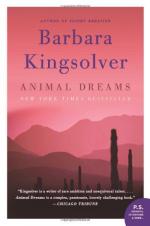|
This section contains 293 words (approx. 1 page at 400 words per page) |

|
Animal Dreams Summary & Study Guide Description
Animal Dreams Summary & Study Guide includes comprehensive information and analysis to help you understand the book. This study guide contains the following sections:
This detailed literature summary also contains Bibliography and a Free Quiz on Animal Dreams by Barbara Kingsolver.
In Barbara Kingsolver's Animal Dreams (1990), Codi Noline, a young woman unsure of her purpose in life, returns to her hometown of Grace, Arizona, to teach high school and care for her father. As the novel unfolds, Codi gradually becomes aware of important political and environmental issues. She also learns that the detached and cynical individualism that has dominated her life is not the best recipe for happiness. Her exposure to Hispanic and Native American culture shows her the value of the communal way of living, which emphasizes deep and lasting ties to family and to the earth. Although her life is blighted by the tragic death of her sister, Hallie, Codi finally finds peace in the knowledge and acceptance of who she is and where she comes from.
Animal Dreams was Kingsolver's second novel. It won high praise for its convincing portrayal of the complex, interconnected web of human life and relationships, and how this web is shaped by time, memory, and culture. The wide scope of the novel, and the way it manages to weave environmental and political issues into the narrative without sounding preachy, was also praised.
The novel contains many of the elements that characterize Kingsolver's work as a whole: a setting in the American southwest, a female protagonist whose way of living is or becomes more cooperative than competitive (which is intended as a contrast between female and male attitudes); a concern for the environment; an admiration of Native American culture, and opposition to U.S. involvement in the politics of Central America.
Animal Dreams can be placed in the tradition of "eco-feminist" literature, which began in the 1980s and includes work by authors such as Ursula Le Guin, Leslie Marmon Silko, Louise Erdrich, and Alice Walker.
Read more from the Study Guide
|
This section contains 293 words (approx. 1 page at 400 words per page) |

|



